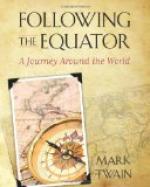CHAPTER LII.
Wrinkles should merely indicate where smiles have
been.
—Pudd’nhead
Wilson’s New Calendar.
In one of those Benares temples we saw a devotee working for salvation in a curious way. He had a huge wad of clay beside him and was making it up into little wee gods no bigger than carpet tacks. He stuck a grain of rice into each—to represent the lingam, I think. He turned them out nimbly, for he had had long practice and had acquired great facility. Every day he made 2,000 gods, then threw them into the holy Ganges. This act of homage brought him the profound homage of the pious—also their coppers. He had a sure living here, and was earning a high place in the hereafter.
The Ganges front is the supreme show-place of Benares. Its tall bluffs are solidly caked from water to summit, along a stretch of three miles, with a splendid jumble of massive and picturesque masonry, a bewildering and beautiful confusion of stone platforms, temples, stair-flights, rich and stately palaces—nowhere a break, nowhere a glimpse of the bluff itself; all the long face of it is compactly walled from sight by this crammed perspective of platforms, soaring stairways, sculptured temples, majestic palaces, softening away into the distances; and there is movement, motion, human life everywhere, and brilliantly costumed —streaming in rainbows up and down the lofty stairways, and massed in metaphorical flower-gardens on the miles of great platforms at the river’s edge.
All this masonry, all this architecture represents piety. The palaces were built by native princes whose homes, as a rule, are far from Benares, but who go there from time to time to refresh their souls with the sight and touch of the Ganges, the river of their idolatry. The stairways are records of acts of piety; the crowd of costly little temples are tokens of money spent by rich men for present credit and hope of future reward. Apparently, the rich Christian who spends large sums upon his religion is conspicuous with us, by his rarity, but the rich Hindoo who doesn’t spend large sums upon his religion is seemingly non-existent. With us the poor spend money on their religion, but they keep back some to live on. Apparently, in India, the poor bankrupt themselves daily for their religion. The rich Hindoo can afford his pious outlays; he gets much glory for his spendings, yet keeps back a sufficiency of his income for temporal purposes; but the poor Hindoo is entitled to compassion, for his spendings keep him poor, yet get him no glory.
We made the usual trip up and down the river, seated in chairs under an awning on the deck of the usual commodious hand-propelled ark; made it two or three times, and could have made it with increasing interest and enjoyment many times more; for, of course, the palaces and temples would grow more and more beautiful every time one saw them, for that happens with all such things; also, I think one would not get tired of the bathers, nor their costumes, nor of their ingenuities in getting out of them and into them again without exposing too much bronze, nor of their devotional gesticulations and absorbed bead-tellings.




